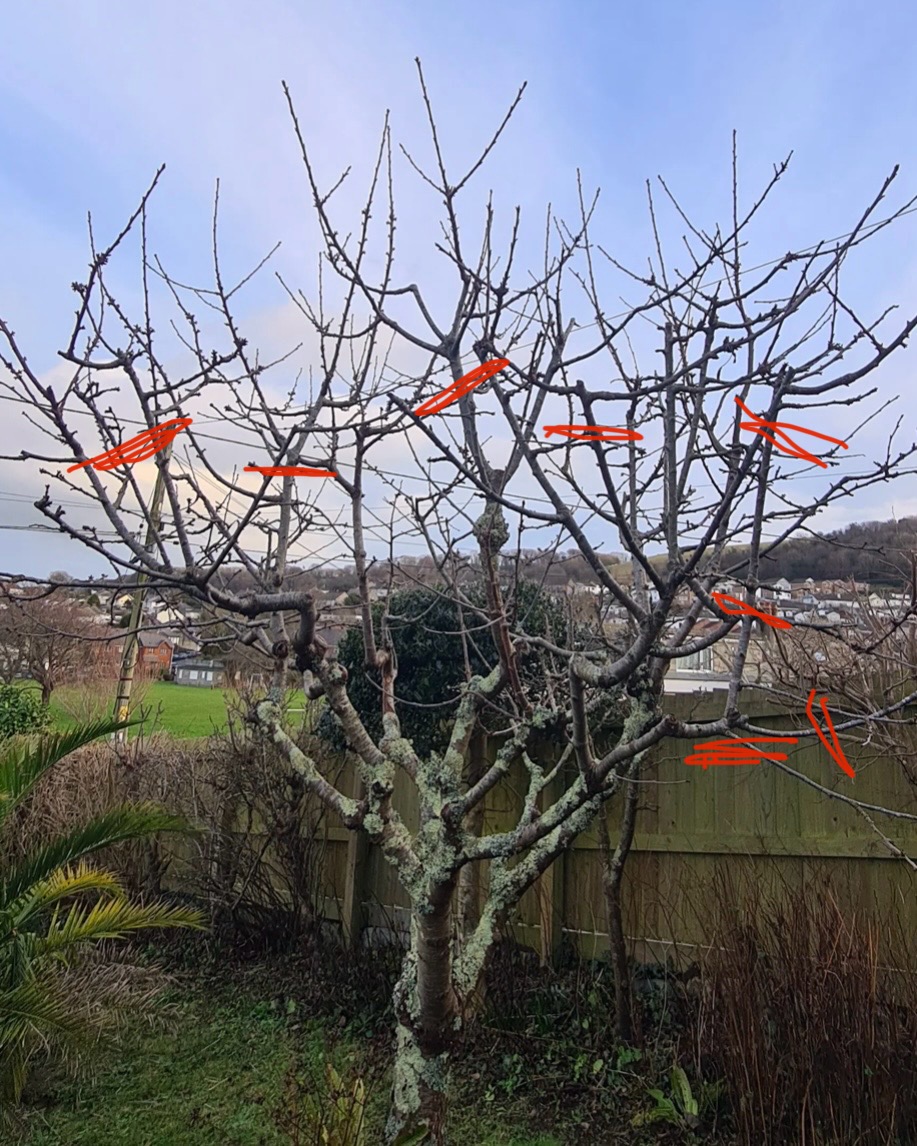Hi @christof1
Great question and yes I get asked this all the time. There’s no silly questions here at Garden Ninja, in fact my moto is to try and help all gardeners no matter what their level of experience is. Cherry tree pruning can throw a lot of new gardeners as a lot of the information online is false. Ie winter pruning!!!
There are two things to remember with pruning cherry trees. The first is to always prune in mid to late summer after the tree has fruited and never in winter. This is because cherry trees are prone to silver leaf disease when pruned in winter.
The second is to aim for an open goblet shape which allows airflow and even spacing of branches. To do this we usually prune out the 3 d’s in summer. Diseased. Damaged. Dead. This opens up the shape. Actually looking at your tree I think this is all it needs in my experience as it’s a nice shape.
However if you do need to reduce the height of your cherry trees the image below will show you a guide to where I would prune it.

Always prune at a 45 degree angle just about a bud or lateral (side branch). If you can’t see a bud rub your nail along the branch until you feel a ridge. This is normally where fresh growth will break from after pruning. Do this in summer. My cherry tree video guide below should help show this in real time.
https://youtu.be/EWPEuJ48kmU?si=G3GYvXIhxpKiGsMX
Here’s some more help for pruning cherries.
Step-by-Step Guide to Pruning a Cherry Tree
1. Prepare Tools & Sterilise
Use sharp, clean secateurs or loppers for small branches.
Use a pruning saw for thicker branches.
Disinfect tools before use to prevent disease spread.
2. Remove Dead, Diseased, or Damaged Wood - the 3 d’s
Cut back any branches that show signs of disease or damage.
Remove crossing or rubbing branches to prevent wounds that invite infection.
3. Thin Out Overcrowded Growth
Open up the centre to improve light and airflow.
Remove any weak, inward-growing, or water shoots (suckers) at the base of the tree.
4. Shape the Tree for Structure & Productivity
For young trees, aim for an open, vase-shaped canopy with 3-5 strong scaffold branches.
For mature trees, shorten long branches to maintain size and encourage fruit-bearing wood.
Always cut just above an outward-facing bud to direct growth away from the centre.
5. Limit Heavy Pruning
Never remove more than 35% of the tree canopy in one season to avoid stress.
Do let us know how you get on!
Lee Garden Ninja
Hi @christof1
Great question and yes I get asked this all the time. There’s no silly questions here at Garden Ninja, in fact my moto is to try and help all gardeners no matter what their level of experience is. Cherry tree pruning can throw a lot of new gardeners as a lot of the information online is false. Ie winter pruning!!!
There are two things to remember with pruning cherry trees. The first is to always prune in mid to late summer after the tree has fruited and never in winter. This is because cherry trees are prone to silver leaf disease when pruned in winter.
The second is to aim for an open goblet shape which allows airflow and even spacing of branches. To do this we usually prune out the 3 d’s in summer. Diseased. Damaged. Dead. This opens up the shape. Actually looking at your tree I think this is all it needs in my experience as it’s a nice shape.
However if you do need to reduce the height of your cherry trees the image below will show you a guide to where I would prune it.

Always prune at a 45 degree angle just about a bud or lateral (side branch). If you can’t see a bud rub your nail along the branch until you feel a ridge. This is normally where fresh growth will break from after pruning. Do this in summer. My cherry tree video guide below should help show this in real time.
https://youtu.be/EWPEuJ48kmU?si=G3GYvXIhxpKiGsMX
Here’s some more help for pruning cherries.
Step-by-Step Guide to Pruning a Cherry Tree
1. Prepare Tools & Sterilise
Use sharp, clean secateurs or loppers for small branches.
Use a pruning saw for thicker branches.
Disinfect tools before use to prevent disease spread.
2. Remove Dead, Diseased, or Damaged Wood - the 3 d’s
Cut back any branches that show signs of disease or damage.
Remove crossing or rubbing branches to prevent wounds that invite infection.
3. Thin Out Overcrowded Growth
Open up the centre to improve light and airflow.
Remove any weak, inward-growing, or water shoots (suckers) at the base of the tree.
4. Shape the Tree for Structure & Productivity
For young trees, aim for an open, vase-shaped canopy with 3-5 strong scaffold branches.
For mature trees, shorten long branches to maintain size and encourage fruit-bearing wood.
Always cut just above an outward-facing bud to direct growth away from the centre.
5. Limit Heavy Pruning
Never remove more than 35% of the tree canopy in one season to avoid stress.
Do let us know how you get on!
Lee Garden Ninja
 Lee Burkhill: Award Winning Designer & BBC 1's Garden Rescue Presenters Official Blog
Lee Burkhill: Award Winning Designer & BBC 1's Garden Rescue Presenters Official Blog



